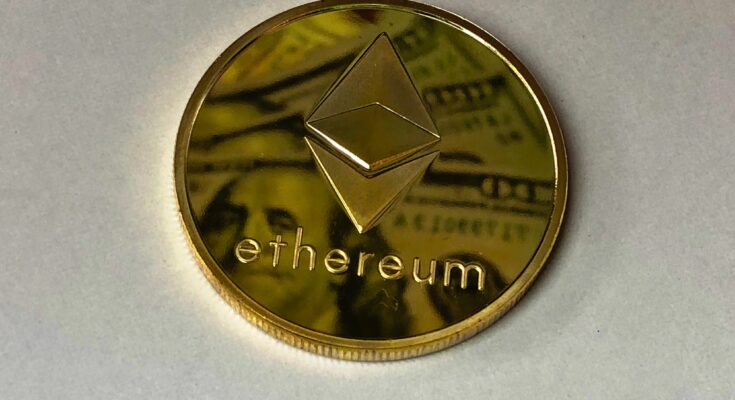What is Ethereum?
Ethereum is an open-source blockchain protocol designed to facilitate the development and execution of decentralized( What is Decentralized Finance) applications (DApps) and smart contracts.
Developers of the Ethereum blockchain protocol decided to create a platform, instead of a new cryptocurrency, that allows for the development and operation of integrated smart contracts and decentralized applications based on cryptocurrency.
What Is Ethereum? : The token associated with Ethereum is called ETH, which is a cryptocurrency that is tied to the blockchain protocol and can be used to pay for smart contract execution or other fees associated with decentralized applications. ETH is a multi-purpose token, with its use cases including data storage, sponsorship of other tokens for businesses, and more.
Ethereum’s blockchain technology allows for decentralized applications to be built and run, which means that they operate without a centralized intermediary or authority. Smart contracts, which are self-executing contracts that automatically enforce the terms of an agreement, are a key feature of the Ethereum protocol.
Overall, Ethereum’s goal is to provide a platform for the development of decentralized applications and the creation of new decentralized systems that can operate in a trustless and transparent manner.
How It Works Ethereum?
Ethereum works by utilizing a blockchain protocol, which is essentially a decentralized, distributed ledger that records transactions and smart contracts on a network of computers.
The Ethereum network consists of nodes that store a copy of the blockchain, and they work together to validate transactions and smart contracts. Each node on the network has access to a copy of the blockchain, which contains a record of every transaction and smart contract that has been executed on the network.
Smart contracts are self-executing contracts with the terms of the agreement written into lines of code. They are stored on the blockchain and are executed automatically when certain conditions are met. This allows for the creation of trustless, decentralized applications that can operate without the need for intermediaries or middlemen.
To execute smart contracts or transfer ETH, users must pay a fee in the form of gas, which is a unit of measurement for the computational effort required to execute the transaction. The gas fee is paid to miners on the network, who verify and execute the transactions and smart contracts.
Ethereum also utilizes a consensus algorithm called Proof of Stake (PoS), which is different from the Proof of Work (PoW) algorithm used by Bitcoin ( What is Bitcoin? Which Blockchain Technology Used? How To Mine Bitcoin?). With PoS, validators (or nodes) are chosen to validate new transactions and create new blocks on the blockchain based on their stake in the network, rather than their computational power.
Overall, Ethereum works by providing a decentralized platform for the development and execution of smart contracts and decentralized applications, powered by the Ethereum blockchain and supported by a network of nodes and validators.
what are the uses of Ethereum?
Ethereum has many use cases, including:
1. Decentralized applications (DApps): Ethereum provides a platform for developers to create DApps that run on the blockchain. DApps can be used in many industries, such as finance, healthcare, real estate, gaming, and more.
2. Smart contracts: Smart contracts are self-executing contracts that automatically enforce the terms of an agreement. They can be used for many purposes, such as digital identity verification, supply chain management, and more.
3. Token creation: Ethereum allows developers to create their own custom tokens on the blockchain. These tokens can be used for a variety of purposes, such as creating new cryptocurrencies, representing assets like gold or real estate, or rewarding users for their participation in a decentralized network.
4. Decentralized finance (DeFi): Ethereum has become a popular platform for decentralized finance( What is Decentralized Finance) applications. These applications include decentralized exchanges, lending platforms, and more.
5. Gaming and digital collectibles: Ethereum’s smart contract capabilities have also been used to create gaming and digital collectible platforms. These platforms allow users to trade and collect unique digital assets.
6. Supply chain management: Ethereum can be used to create transparent and traceable supply chains. Smart contracts can be used to verify the origin and authenticity of products, track their movement through the supply chain, and automate payments and other processes.
7. Identity verification: Ethereum’s smart contract capabilities can be used to create secure and decentralized identity verification systems. These systems can be used to verify user identities for a variety of purposes, such as voting, financial services, and more.
Overall, Ethereum’s versatility and programmability make it a powerful platform for a wide range of use cases.
Who runs Ethereum?
Ethereum is an open-source decentralized platform, which means that it does not have a central authority or organization that controls it. However, the Ethereum network is maintained and developed by a community of developers, miners, and users who are collectively responsible for its operation and evolution.
The Ethereum( https://ethereum.org/en/what-is-ethereum/) Foundation, a non-profit organization based in Switzerland, played a critical role in the early development of the platform and still provides support for various aspects of the ecosystem. However, the day-to-day operation of the network is primarily carried out by its community of users and developers, who participate in various activities such as mining, developing new applications, and contributing to the ongoing development of the Ethereum protocol.
What About Ethereum’s energy utilization?
Ethereum, like other blockchain networks, does consume a significant amount of energy to power its operations. This
is primarily due to the process of mining, which involves solving complex mathematical problems to verify transactions
and create new blocks on the chain.
According to the Cambridge Bitcoin Electricity Consumption Index, as of April 2023, the annual electricity consumption of the Ethereum network is estimated to be around 87.67 TWH(terawatt-hours), which is equivalent to the energy consumption of a mid-sized country like Austria. This energy consumption contributes to carbon emissions, which have raised concerns about the environmental impact of blockchain-based systems.
However, it’s worth noting that Ethereum, like other blockchain networks, is working on ways to reduce its energy
consumption. One proposed solution is to shift from proof-of-work (PoW) to proof-of-stake (PoS) consensus algorithms, which require much less energy to operate. The Ethereum community is currently working on implementing a PoS consensus algorithm called Ethereum 2.0, which is expected to significantly reduce the network’s energy consumption.
Disclaimer: The financial and crypto market information provided on Blogbia is intended for informational purposes only and should not be construed as investment advice. It is highly recommended that you conduct your own research and seek guidance from financial experts before making any investment decisions. The decision to continue reading the content on this website is entirely at your own discretion, and it shall be understood as an express acknowledgment and agreement that Blogbia shall be released from any potential legal action or enforceable claims that may arise.





One Comment on “What Is Ethereum? How It Works And More Details In Ethereum? 7 Uses of Ethereum”